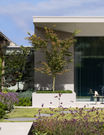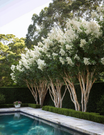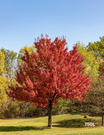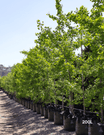Magnolias are a popular addition to many gardens, prized for their beauty and versatility. For those looking to create dense hedge, the Magnolia Teddy Bear, Little Gem, Kay Parris and the Supergem are excellent choices. If you're seeking impactful feature trees, consider Coolwyn Gloss, Greenback or Magnolia Alta.
These varieties all have their unique traits and benefits, so continue reading to discover more about each one and find the perfect magnolia for your outdoor space.

The Best Magnolias for Hedging
When it comes to hedging, the choice of magnolia can dramatically affect the final aesthetic and functional outcomes. Here are our top recommendations:
1. Magnolia Teddy Bear:
The Magnolia Teddy Bear is the epitome of compactness, making it ideal for smaller gardens or courtyards where space is at a premium. It can be pruned and shaped easily to fit into tight spaces. Its large, creamy-white flowers and glossy dark green foliage create an eye-catching backdrop.
- Mature Height: 2.4-3 meters
- Mature Width: 1.8-2.4 meters
- Best Use: Highly suitable for dense hedging or as a feature tree in smaller gardens
- Compactness: Highly Compact
- Leaf Appearance: Glossy, dark green, elliptical leaves
- Flowers: Flowers are average size but less in number than 'Little Gem' & 'Kay Parris'
2. Magnolia Little Gem:
While not as compact as the Teddy Bear, the Magnolia Little Gem offers a bit more height and spread, making it a great choice for creating small hedges or screens. If given enough space, it can serve as an impressive standalone feature.
- Mature Height: 6-7.5 meters
- Mature Width: 3-4.5 meters
- Best Use: Ideal for creating semi-dense hedges or as a standalone feature tree
- Compactness: Moderately Compact
- Leaf Appearance: Dark green, shiny, and elongated oval leaves
- Flowers: Large, creamy white, fragrant flowers. Prolific flowerer and a yardstick for flowering ability, outblossoms Teddy Bear and matches Kay Parris
3. Magnolia Kay Parris:
The Kay Parris Magnolia features a growth habit that is a bit more compact than the Little Gem but not quite as dense as the Teddy Bear. With its early and extended flowering season, it's a great choice for adding an extended splash of color to your hedge.
- Mature Height: 3-4.5 meters
- Mature Width: 2.4-3 meters
- Best Use: Perfect for small hedges, borders, or as a feature tree in smaller gardens
- Compactness: Intermediate Compactness
- Leaf Appearance: Dark green, Deeper brown underside, wavy-edged, oblong leaves
- Flowers: Larger flowers but less in number
4. Magnolia Supergem:
The Magnolia Supergem offers a more upright growth habit, reaching higher and spreading less. This makes it perfect for creating a captivating vertical accent in the garden.
- Mature Height: 6-7.5 meters
- Mature Width: 4.5-6 meters
- Best Use: Perfect as a towering feature tree in larger landscapes
- Compactness: Moderately Compact
- Leaf Appearance: Deep green, large, oval-shaped leaves
- Flowers: Blooms abundantly during the flowering season, more prolific than Teddy Bear but less than Little Gem and Kay Parris
The Best Magnolias to use as Feature Trees
In the realm of feature trees, magnolias stand out for their striking blooms and aesthetic appeal. Here are some top picks:
1. Magnolia Coolwyn Gloss:
The Coolwyn Gloss Magnolia is a versatile variety that works well in larger gardens or landscapes. With its large, tulip-shaped flowers and glossy, green foliage, it serves as a standout feature tree.
- Mature Height: 6-7.5 meters
- Mature Width: 4.5-6 meters
- Best Use: Perfect as a towering feature tree in larger landscapes
- Compactness: Moderately Compact
- Leaf Appearance: Deep green, large, oval-shaped leaves
- Flowers: Blooms abundantly during the flowering season, more prolific than Teddy Bear but less than Little Gem and Kay Parris
2. Magnolia Greenback:
The Magnolia Greenback stands out due to its distinctive glossy, dark green leaves without brown undersides. This feature tree maintains its attractive appearance year-round and is slightly smaller than the Supergem, making it a good option for smaller landscapes.
- Mature Height: 4-6 meters
- Mature Width: 3-4.5 meters
- Best Use: Ideal as a feature tree in larger gardens and landscapes, but can also be used in smaller spaces
- Compactness: Moderately Compact
- Leaf Appearance: Glossy dark green, without brown undersides
- Flowers: Goblet-shaped flowers. Profuse bloomer during the flowering season, similar in abundance to Supergem but less than Little Gem and Kay Parris.
3. Magnolia Alta
A variety with an unmistakably elegant allure, the Magnolia Alta is often selected as a focal point in gardens due to its strong architectural form and decorative leaves. This evergreen magnolia is also favored for its hardiness, making it a resilient choice in a variety of climate conditions.
Mature Height: 4-6 meters
Mature Width: 2-3 meters
Best Use: Its upright, narrow form makes it an excellent choice for a screening tree or a stunning feature tree.
Compactness: Moderately Compact
Leaf Appearance: Large, dark green leaves with rusty undersides that reveal themselves in the wind, providing a beautiful contrast.
Flowers: Large, tulip-shaped, fragrant flowers that bloom generously from late spring into summer, with sporadic flowering throughout the rest of the year.

Practical Tips for Planting and Maintaining Magnolias
-
Timing: Early Spring or late Autumn is the ideal time to plant most magnolia varieties. These are the times when the tree can establish roots in the cooler soil before the hot summer temperatures or winter frost sets in.
-
Location: Choose a spot that gets full sun to partial shade. Magnolias are versatile but most varieties bloom best in full sun.
-
Soil: Magnolias are generally adaptable and thrive in a range of soil types. However, they prefer slightly acidic, well-draining soil. Improve your soil by adding compost or well-rotted manure before planting. It's always beneficial to amend the soil with compost or a slow-release fertilizer during planting to provide the necessary nutrients for the initial growth phase. Care should be taken not to waterlog the soil, as this can lead to root rot.
-
Watering: Magnolias need regular watering, especially in the first few years as they establish. If the soil feels dry 2 inches below the surface, it's time to water.
-
Mulching: Mulching around the base of the tree will help retain soil moisture and suppress weeds. Be careful not to mound mulch up against the trunk, though, as this can lead to rot.
-
Pruning: Pruning is generally unnecessary except to shape the tree or remove dead or damaged wood. If you need to prune, do so in late winter or early spring before the new growth starts.
These tips will ensure your magnolia thrives and blooms to its full potential for years to come, whether it's in a large landscape or a compact courtyard.
When and How Should You Feed and Fertilise Your Magnolias in Australia?
In Australia, feed and fertilise your magnolias during active growth periods, primarily in early spring and summer. Use a balanced, slow-release fertiliser, ideally formulated for acid-loving plants. Apply the fertiliser under the tree canopy, avoiding the trunk, after watering the soil thoroughly. Follow with another round of watering to help the fertiliser reach the root zone. Always adhere to the instructions on the fertiliser package to avoid over-fertilising.
Whichever magnolia you choose, you're sure to enjoy the magnificent blooms and enchanting presence they bring to your landscape. The variety you select should align with your preferences, garden requirements, and the intended purpose (hedging or feature tree).










































4 comments
Diane Cook
Great blog; the detail is so helpful.
Grace
Great post with valuable info, Thank you!
Dion Bright
Really good post. Very helpful. Would like to have see details on growth speed and ideal soil type too. Thanks.
Suneiah
Such a great post. Thank you.
Leave a comment
This site is protected by hCaptcha and the hCaptcha Privacy Policy and Terms of Service apply.